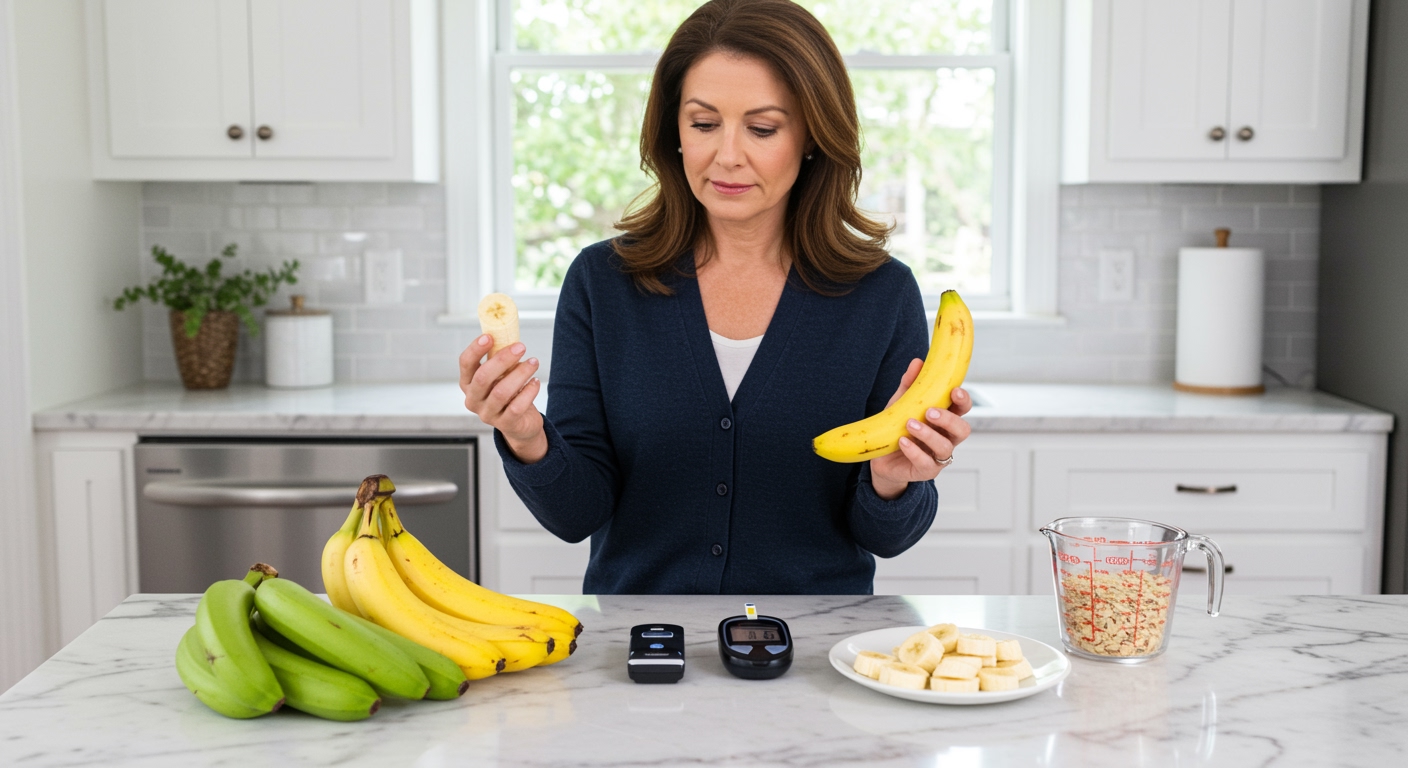✪ Key Takeaway: Bananas can be part of a diabetes-friendly diet when you choose less ripe ones and control portion sizes properly.
Introduction
You reach for a banana at the grocery store and suddenly freeze.
Your mind races with questions about blood sugar spikes and whether this yellow fruit will sabotage your diabetes management efforts.
Hi, I’m Abdur, your nutrition coach and today I’m going to explain exactly how bananas affect your blood sugar and share the science-backed strategies that make them safe for people with diabetes.
How Do Bananas Actually Affect Blood Sugar?
Bananas contain three main types of carbohydrates that directly impact your blood glucose levels.
A medium banana provides about 27 grams of carbohydrates, including natural sugars like glucose, fructose, and sucrose.
When you eat a banana, these sugars enter your bloodstream at different rates depending on the fruit’s ripeness level.
Green bananas contain more resistant starch, which your body digests slowly and causes a gradual blood sugar rise.
As bananas ripen and develop brown spots, the starch converts to simple sugars that your digestive system absorbs much faster.
This biochemical transformation explains why overripe bananas can cause rapid glucose spikes while green ones provide steadier energy release.
✪ Pro Tip: Choose bananas with minimal brown spots to minimize blood sugar impact.
What Makes Banana Ripeness So Important?
The glycemic index of bananas changes dramatically as they ripen from green to yellow to brown.
Green bananas have a glycemic index of 30, which falls into the low category and causes minimal blood sugar elevation.
Yellow bananas with some green tips score around 51 on the glycemic index, placing them in the medium range.
Overripe bananas with brown spots can reach a glycemic index of 62 or higher, entering the high category that triggers rapid glucose increases.
This happens because enzymes break down complex starches into simple sugars during the ripening process.
Your pancreas must work harder to produce insulin when you eat ripe bananas compared to green varieties.
People with diabetes benefit most from choosing bananas that still have some green coloring and firm texture.
✪ Fact: Green bananas contain up to 80% resistant starch compared to just 1% in ripe bananas.
Does Portion Size Really Matter With Bananas?
The size of your banana portion directly determines how much your blood sugar will rise after eating.
A small banana contains about 19 grams of carbohydrates, while a large one can pack 35 grams or more.
Most diabetes educators recommend limiting fruit servings to 15 grams of carbohydrates at one time.
This means eating half of a medium banana provides the ideal portion size for blood sugar management.
Your body can handle smaller amounts of natural fruit sugars more effectively than large doses that overwhelm your insulin response.
Combining banana portions with protein or healthy fats further slows sugar absorption and prevents glucose spikes.
Try pairing half a banana with almond butter or adding banana slices to Greek yogurt for better blood sugar control.
✪ Note: Measuring your banana portions helps maintain consistent carbohydrate intake throughout the day.
When Should You Eat Bananas For Best Results?
Timing your banana consumption can significantly impact how your body processes the natural sugars.
Eating bananas before physical activity allows your muscles to use the glucose for energy instead of storing it as fat.
Your insulin sensitivity is naturally higher in the morning, making breakfast or pre-workout the optimal times for banana consumption.
Avoid eating bananas late in the evening when your metabolism slows down and glucose clearance becomes less efficient.
Post-meal blood sugar monitoring shows that people with diabetes experience smaller glucose increases when they eat fruit earlier in the day.
Your circadian rhythm affects how your body responds to carbohydrates, with better glucose tolerance during daylight hours.
Consider eating your banana portion as part of a balanced breakfast rather than as an isolated snack.
✪ Pro Tip: Test your blood sugar 2 hours after eating bananas to understand your individual response.
Are There Better Fruit Options For Diabetes?
While bananas can fit into a diabetes-friendly diet, some fruits offer better blood sugar control.
Berries like strawberries, blueberries, and raspberries contain fewer carbohydrates and more fiber per serving than bananas.
Apples with their skin provide sustained energy release due to their high fiber content and lower glycemic impact.
Citrus fruits like oranges and grapefruits offer vitamin C benefits with minimal blood sugar elevation.
However, bananas provide unique benefits including potassium for heart health and vitamin B6 for nerve function.
The key is rotating different fruits throughout your week rather than relying on any single option.
Your individual glucose response may vary, so personal testing helps determine which fruits work best for your diabetes management.
✪ Fact: One cup of berries contains only 12 grams of carbs compared to 27 grams in a medium banana.
The Bottom Line
Bananas can absolutely be part of your diabetes management plan when you make smart choices about ripeness, portion size, and timing.
The secret to enjoying any food with diabetes is understanding how it affects your unique body and making adjustments accordingly.
I encourage you to share your experiences with bananas and blood sugar in the comments below, and feel free to ask any questions about incorporating fruits into your diabetes-friendly eating plan.
At NutritionCrown, we use quality and credible sources to ensure our content is accurate and trustworthy. Below are the sources referenced in creating this article:
- Healthline: 11 Evidence-Based Health Benefits of Bananas
- PubMed: Glycemic Index and Diabetes Research
- Signos: Glycemic Index of Banana
- WebMD: Fruit and Diabetes





